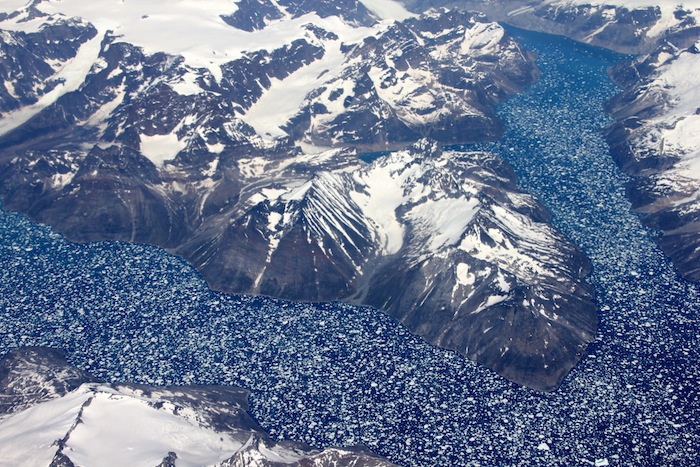
By Anne McClintock
2012 has been the Goliath year of climate change, and it is all about the ice.
By the middle of the year, climate numbers were tipping into record superlatives: hottest summer in human history, worst droughts, wildest fires, worst floods, highest rivers, worst storms, lowest rivers, worst winters, thinnest polar bears, fewest bees, and no more Lonesome George, the Galapagos tortoise, last of his kind, who died in June. And everywhere the stealthy rising of the seas.
But one fact towered above the rest: the colossal melt of Greenland.
In July of this tipping-point summer, scientists stared at statistics so startling they thought at first there was some mistake. Satellite images showed that in four days alone, the vast ice surface of Greenland had melted from white to dark. 97 percent of the snow cover, parts of which had been frozen for 18 million years, had melted into a sheen of ice-water.
Normally phlegmatic scientists were stunned. “Unprecedented,” said Jay Zwally, a NASA glaciologist, who had to move camp when the ice beneath them melted. “To have the melt cover the whole of Greenland like this is unknown.”
The dark crevasses of Greenland’s coastal mountains were sloughing off their ancient sheath of snow, the great tongues of the glacial rivers thinning, the ribs of the earth visible to the sun for the first time in 100,000 years.
The great Arctic ice domes have shrunk to their smallest size in human history, melting faster than ever recorded. An ice surface the size of the US and Mexico combined has gone.
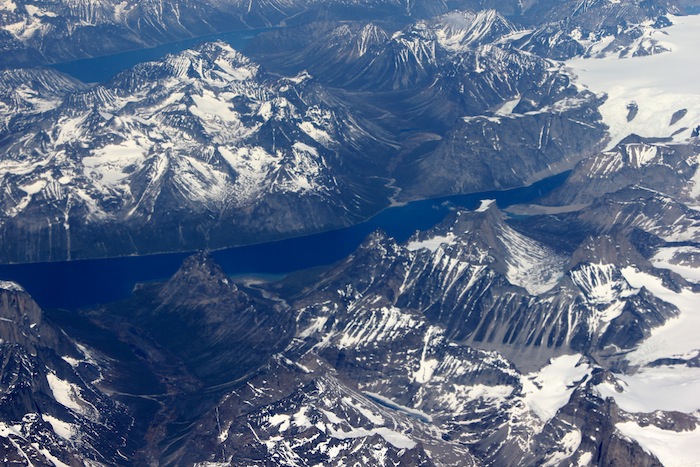
A few days before the great melt, an ice-slab the size of Manhattan sheared off the Petermann Glacier. The fraying edges of Greenland are slipping into the sea. Blooms of algae are sprouting for the first time beneath the permafrost of the Arctic ocean, feeding off sunlight filtering through the blue melt caverns and pools. For the first time in human history, lightening ignited the tundra into great fires, the soot darkening the snow, absorbing more heat and speeding the melt. New Arctic shrubs are growing; moss and lichen are vanishing. The red fox has pushed north and the Arctic fox has nearly gone.
Scientists predict that in less than ten years the Arctic will be completely, irreversibly free of summer ice. In less than ten years it will be possible to kayak across the north pole.
I myself flew over Greenland in a commercial plane. Outside the window, the clouds parted. Far below lay an unearthly landscape. Something looked beautifully, surreally wrong, but what was it? The dark crevasses of Greenland’s coastal mountains were sloughing off their ancient sheath of snow, the great tongues of the glacial rivers thinning, the ribs of the earth visible to the sun for the first time in 100,000 years.
As our plane flew on, leaving carbon emissions and Greenland behind us, I saw white spirals of ice spinning across the sea like a galaxy of spilt stars.

Why does the Big Melt matter?
The polar ice-sheets act like a gigantic mirror, reflecting back the sun’s heat, and cooling the earth. Now as the white snow melts, the darkened ice-melt absorbs more heat, and the process speeds up into a positive feedback loop, a self-perpetuating, unstoppable spiral. Taken together, Greenland, West Antartica and the Antarctic Peninsula are all shrinking on a scale and speed unforeseen. Antarctica predictably gained ice-mass because it gets more snowfall with climate warming, but not enough to offset the Arctic’s loss.
And as the ice melts, the seas rise.
Scientists tell us that 344 billion tons of Arctic ice has melted. But 344 billion tons is magical counting. Our minds cannot contain such magnitude.
This summer, 26 alarmed polar-research teams crunched their numbers and came up with the first joint assessment and the first reliable estimate: polar melting has produced 20 percent of the overall sea-level rise since 1992. Three quarters of that is from Greenland.
There are two ways that global warming causes sea levels to rise: more carbon dioxide means more heat, which warms the oceans, and as they warm, they rise. As the planet warms, the ice-sheets melt faster, the melting ice pours into the oceans, which rise even higher with the new water. Even the most optimistic scientists say we are going to face rising seas and drowning cities, no matter how well we behave with cutting emissions. Even if we stopped putting all carbon emissions into the air tomorrow, nothing we can do will stop the process, we can only slow it.

Climate change seems abstract. Scientists tell us that 344 billion tons of Arctic ice has melted. But 344 billion tons is magical counting. Our minds cannot contain such magnitude.
The problem is not precision. The problem is perception.
We can see the fractal veins in a leaf and its twinned tracery in the palm of our hands, but we can’t see the bigger fractal of the Mississippi marshes slipping into the sea one football field every half an hour.
The word “glacial” used to mean “slow.” Now “glacial” signals the speed of climate change, a speed our brains cannot visualize. And if we can’t picture it, how can we be motivated to prevent it?
We are told that 4.5 million square miles of Greenland melted, and to get the point across scientists tell us Greenland is three times the size of Texas. But if we can’t imagine the size of Texas, how can we imagine three times that amount?
Our senses are tuned to the tiny, intimate signs of the years’ turnings: the first blush of tulips, the green sunlight of spring, the soft sifting of snow. We can see the fractal veins in a leaf and its twinned tracery in the palm of our hands, but we can’t see the bigger fractal of the Mississippi marshes slipping into the sea one football field every half an hour. Our minds can’t crunch the big numbers. Our ears can’t hear the seeping rise of the oceans. Our fingertips can’t sense that the warming oceans are bleaching the coral reefs bone-white.
A new study by the National Center for Atmospheric Research says that by 2100, the seas will have risen by 2 to 7 feet. A three-foot sea rise might not seem like much, but it would leave downtown Miami an island, cut off from the rest of the continent. Norfolk, Virginia, would be drowned by a Category 3 hurricane. Florida’s adaptation costs would go sky-high as the coast went underwater. Lower Manhattan would disappear.
Climate change seems abstract. A new OECD report tells us that by the 2070s millions of people in the cities most vulnerable to the sea rise will be at risk from coastal flooding: 14 million in Calcutta, 11 million each in Mumbai and Bangladesh, 10 million in Guangzhou, 4 million in Alexandria, and 3 million each in Lagos and New York.
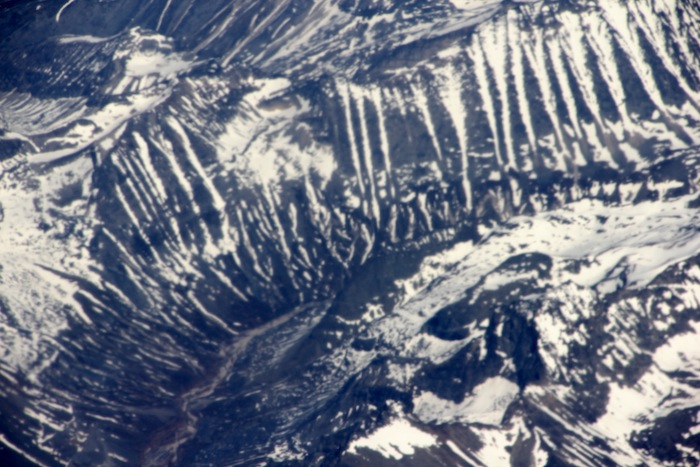
All these numbers speed across the retina like a nightmare ticker-tape, too fast to be turned into visible scenes, too fast to be imaginatively comprehended. Our imaginations are not suited for picturing the vastness of the ice-cap melts, the tininess of nitrogen molecular change, or billions of future people learning to lead amphibious lives.
By 2300, sea levels could rise by about 34 feet, sinking South Florida entirely. New Orleans would vanish. The whole of the Netherlands gone. Shanghai gone. And the whole of Bangladesh.
But that’s 200 years away.
200 years seems abstract. The problem is perceptual. We can’t easily visualize the scale and time of climate threat. Because we can’t see, we have created satellites that travel silently overhead, their robot eyes opening and closing, recording the blue planet we are slowly undoing.
The vast ice-domes of the Arctic are the keepers of the earth’s memory. Far down in the Jules Verne depths of the permafrost, ancient air is trapped in tiny ice-bubbles that is the same air it was 18 million years ago. These minute bubbles are time-capsules from the past, trapping the air our ancestral forbears breathed, a unique record of the earth’s climate history. As the ice melts, the planets’ memory falters and is lost.
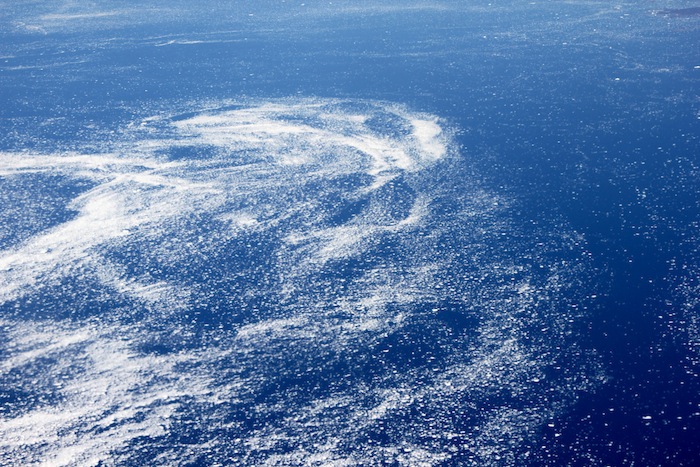
Climate change seems abstract. So, in 2007, acclaimed wilderness photographer, James Balog, set out to document the vanishing of the glaciers. A climate-change skeptic himself in his early career, he saw his first melting glacier on an expedition for National Geographic in 2005. “If I hadn’t seen it in pictures,” he says, “I wouldn’t have believed it at all.” He launched the Extreme Ice Survey (EIS), installing 27 time-lapse cameras at remote glacier sites in Greenland, Iceland, Nepal, Alaska and the Rocky Mountains to film glaciers melting over time, now gathered into an award winning film directed by Jeff Orlowski, called “Chasing Ice: Ground Zero of Climate Change.”
“Chasing Ice” is the digital memory-keeper of landscapes that are no longer there. The film records what the eye cannot see: vast rivers of ice as they crunch and shove their way to the sea, where they halt and pile up against each other in massive, erect cliffs of calving ice. Glaciers do not melt gracefully like ice-cubes, they collapse catastrophically, shearing off great shoulders of blue-green ice, sending vast snowy skyscrapers shooting hundreds of feet into the air, crashing back into the water and releasing a tumult of waves. Orlog’s time-lapse cameras fast-forward time, compressing years into seconds, offering a pyrotechnically gorgeous vision of the calamitous sublime.
Here, a full season of presidential debates can pass by without either candidate uttering the words climate change.
Climate change seems abstract. But who amongst us could not sense this year that something has subtly shifted, that the strange weather scorching the skeletal trees, blackening the roots and bleaching the corn is now the new normal? Gardeners like myself knew the flowers were misbehaving, that the bees had not come. Farmers watched mile-high dust-storms rub out the horizon. Floods and frogs came to Australia and Pakistan; droughts ravaged Russia and China; wildfires devoured mountains and torched the tundra. Everything a record.
The future has arrived, but at different speeds for different peoples on the planet. The Maldives are drowning. Tuvalu is soon to go.
What we can expect is the unexpected; what we can predict is the unpredictable; what we can trust is that the strange weather that has afflicted the entire planet this tipping-point year is here to stay.
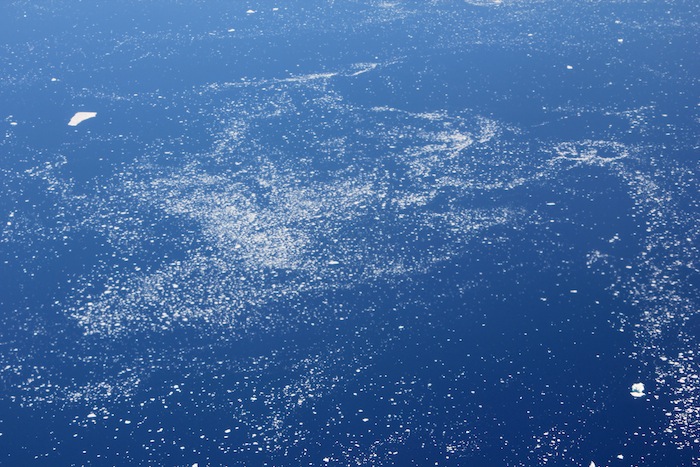
Here in the United States, a full season of presidential debates can pass by without either candidate uttering the words climate change. Then, just after the debates, the rising seas from the Arctic ice-melt, combined with the warm air-dome over the Arctic, amplified the magnitude of Hurricane Sandy, turning it into the biggest storm ever to roil the Atlantic, crashing into the most valuable real estate on the planet, and punching a $79 billion hole in the US climate silence.
Climate change seems abstract. But the conversation has begun. Now we need more creative strategies for making it visible, tangible, real. As Balog puts it: “Bear witness. Tell the story and give voice to the landscape. Sound the alarm.”
Anne McClintock is the Simone de Beauvoir Professor of English and Gender Studies at UW-Madison Wisconsin.

